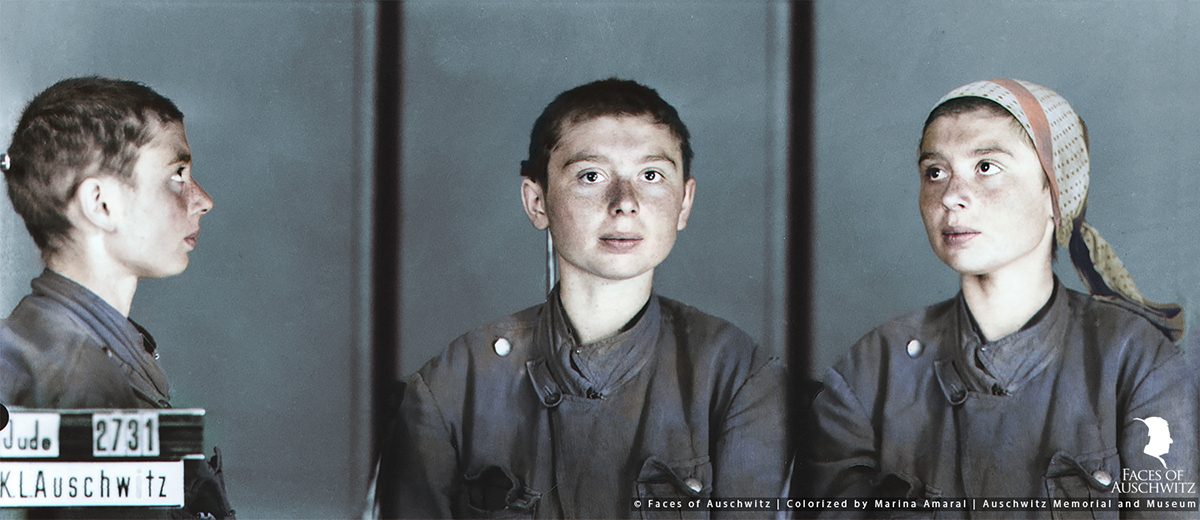Telling the personal stories of the prisoners of the German Nazi Auschwitz camp is important, and in some cases, difficult. During the evacuation of the camp in the final days of the Nazi’s war with the Allied forces, the SS authorities who were responsible for the Auschwitz’s operation, destroyed most of the camp’s documentation. This included their prisoner’s registration cards.
Prisoners photos were also destroyed: approximately 80,000 photos were taken. The Auschwitz Memorial Archive stores and preserves 38,916 these photos. They include 31,969 photos of men and 6,947 photos of women.
In this instance, we have photographs, but we know little about the girl in the picture. We do not know her name or her birthday. We only know her number: 2731.


2731 was deported to Auschwitz in an RSHA (Main Reich Security Office) transport from Bratislava on March 28, 1942. There were 798 Jewish women in this group. They received numbers ranging from 1999 to 2796. We do not know the fate of female prisoner number 2731.
Approximately 26 thousand Slovak Jews were deported to Auschwitz (according to the borders during the World War 2).
The Holocaust In Slovakia
Though nominally independent, Slovakia was highly dependent on Nazi Germany after the dismemberment of Czechoslovakia. In November 1940, Slovakia joined the Axis when its leaders signed the Tripartite Pact. In fulfillment of the requirements of the Axis partnership, Slovakia participated in the invasion of the Soviet Unionin June 1941 and declared war on Britain and the United States in December 1941.
Slovakia was also the first Axis partner to consent to the deportation of its Jewish residents in the framework of the “Final Solution.” According to a census of December 15, 1940, there were about 88,951 Jews in Slovakia. In March 1942, Slovakia signed an agreement with Germany that permitted the deportation of the Slovak Jews. Between March and October 1942, Slovak gendarmes, assisted by Slovak military personnel, units of the Slovak People’s Party’s paramilitary organization, the Hlinka Guard, and members of the Slovak ethnic German paramilitary formation Freiwillige Schutzstaffel (Volunteer SS), concentrated some 57,000 Slovak Jews in indigenously established labor and concentration camps—mainly in the camps Sered, Novaky, and Vyhne.
The Slovak authorities then transported the Jews to the border of the Government General or the German Reich and turned them over to German SS and police. German authorities killed virtually all of these Jews in Auschwitz, Lublin/Majdanek, Sobibor, and other locations in German-occupied Poland. Perhaps 300 survived the war. Among them were Alfred Wetzler and Walter Rosenberg (alias Rudolf Vrba), who escaped from Auschwitz in the spring of 1944 and compiled the first detailed report on operations there for general dissemination in the west.
As reports, in part passed on by the Papal Nuncio in Bratislava, reached the Tiso government that the German authorities were murdering the Slovak Jews in German-occupied Poland, the Slovak President hesitated, and then refused, to deport the remaining 24,000 Jews in Slovakia in the autumn of 1942. During the deportations, some 6,000 Slovak Jews escaped to Hungary. On August 29, 1944, however, Slovak underground resistance organizations, Communist and non-Communist, rose against the Tiso regime as Soviet troops entered neighboring Subcarpathian Rus.
As the Slovak authorities were helpless to quell the uprising, German troops moved in. Einsatzgruppe H of the Security Police and SD, whose duties included rounding up and killing or deporting the remainder of the Slovak Jews, accompanied the Wehrmacht into Slovakia. Between September 1944 and the end of the year, German units deported approximately 12,600 Slovak Jews, most of them to Auschwitz, Theresienstadt, and other camps in Germany. German and Hlinka Guard units killed a few thousand Jews caught in hiding or fighting with the partisans in Slovakia.
Perhaps half of the Jews deported out of Slovakia during and just after the uprising ended in October 1944 survived. Thousands of Jews remained in hiding in Slovakia. In all, German and Slovak authorities deported more than 70,000 Jews from Slovakia; the Germans murdered more than 60,000 of them.
The Germans and their collaborators killed approximately 263,000 Jews who had resided on the territory of the Czechoslovak Republic in 1938.
Source: USHMM.
Please do not share the photos without proper attribution and context.
Special thanks to Auschwitz Memorial and Museum for collaborating with me on this project and providing all the information above. Sponsored by the Michael Frank Family Charitable Fund. Contributor: Seamus Bellamy.
